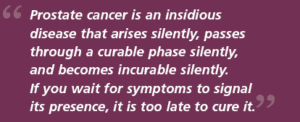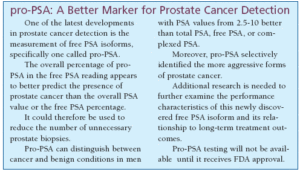Improving Prostate Cancer Detection
(This article is adapted for Quest readers from an article by Stacy Loeb, MD and William J. Catalona, MD: PSA Isoforms: The Next Generation of Prostate Cancer Detection in Clinical Laboratory News, March 2007)
 PSA Screening Works
PSA Screening Works
PSA screening has proved useful in detecting prostate cancer early enough for life-saving treatment.
PSA screening has proved useful in detecting prostate cancer early enough for life-saving treatment.
In the US, the proportion of men with metastatic disease at the time of diagnosis has decreased from 16% in 1985-1989 to 4% in 2003.
The age-adjusted prostate cancer-specific death rate has decreased by 32.5% between 1995 and 2003.
The World Health Organizations global statistics also reflect these trends, with decreasing prostate cancer mortality rates in countries where PSA screening and active treatment are widely practiced and continued increases where they are not.
PSA Screening Has Limitations
Still, PSA-based screening has limitations:
Approximately one-third of prostate cancers detected at PSA level of or above 4 ng/mL have already spread to the prostate capsule or beyond. And approximately 15% of men with a PSA less than 4 have prostate cancer that is detectable by needle biopsy.
The Prostate Cancer Prevention Trial showed than even men with negligible PSA levels of 0.5 or less had prostate cancer detection rates upon biopsy of 6.6%.
The data from this trial highlight the difficulty of using PSA in clinical practice, since no absolute PSA threshold exists below which the risk of prostate cancer is eliminated.
Although many doctors now use a PSA 2.5 ng/mL as the absolute threshold for recommending a prostate biopsy, the issue of using any threshold value remains controversial.
More Accurate Predicators: PSA Velocity, free PSA and pro-PSA 
In fact, more and more evidence suggests that a measure of the change in total PSA over time, such as PSA velocity, may actually be a more important predictor of significant prostate cancer than the PSA level itself.
PSA exists in blood serum in several different forms: the so-called free or unbound form, and the complexed forms in which PSA is attached to other molecules.
In the early 1990s, researchers discovered that the proportion of PSA in the free form known as percentage free PSA is significantly higher among men with enlarged prostates (BPH, benign prostatic hyperplasia) than among men with prostate cancer.
Later studies showed that in men with a percentage free PSA greater than 25%, fewer than 8% had prostate cancer upon biopsy.
By contrast, in men with a percentage free PSA less than 10%, 56% had prostate cancer upon biopsy.
Based on these studies, in 1997 the FDA approved the free PSA test as an aid to prostate cancer detection.
Further studies now show that free PSA is actually comprised of several different components called isoforms.
pro-PSA 
Another isoform of free PSA called pro-PSA seems to be more elevated in men with prostate cancer. Measurement of pro-PSA is usually expressed as the ratio of pro-PSA to free PSA, or percentage pro-PSA.
In addition, pro-PSA may be associated with prostate cancer aggressiveness. For example, among men treated with radical prostatectomy (Dr. Catalona), an increased percentage of pro-PSA was significantly associated with a high Gleason grade and extacapsular tumor extension.
Long-term follow-up has not yet been reported but a preliminary analysis from our surgical database suggests that the 7-year progression-free survival is significantly lower among men with elevated preoperative levels of certain forms of pro-PSA.











